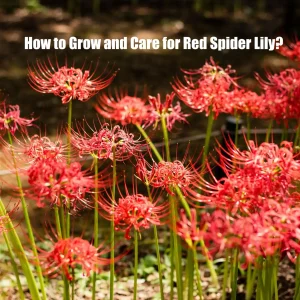The red spider lily, also known as Lycoris radiata, is a beautiful and eye-catching flower that can add a pop of color to any garden. Red spider lilies are easy to grow, and this article will provide you with a comprehensive guide on how to grow and care for red spider lilies, from planting the bulbs to dealing with common pests and diseases.

Introduction about Red Spider Lily
Origin of Red Spider Lily
The Higanbana genus, occasionally known as the Red spider lily, is a bulbous flowering plant that is part of the Amaryllis family. They originate from Asia but have become popular in the Southern United States. The name “spider lily” comes from the long, delicate petals that resemble spider legs.
They are often made citizens and regularly placed in gardens in various locations. They have been represented as symbols of death and rebirth for an extended period in the traditional Japanese culture. These blossoms have also been extensively used within Buddhism, where they are worshipped as sacred flowers.
Characteristics
They are thriving perennial plants that can reach heights of 40-70 cm (15-28 inches) and have a width of 1.5 ft. They stand out from other plants because they continue growing even during hibernation. Its leaves fall off in the late summer and early fall it will be blooming season. From September to October, these spider lilies awake and start to grow.
Their beautiful blossoms stay vibrant for approximately two weeks before changing to pink. The plant resembles a reddish bulb with a tall stem, curled stamens, and petals. In ancient times, native to Japan used them as a deterrent against wild rats and other creatures in their rice fields.
The level of poison
Spider lily’s lower roots exhibit more toxicity than the rest of the plant. In humans, the abdominal region may experience discomfort. If ingested, typical symptoms include feelings of nausea and episodes of vomiting.
This happens due to lycorine toxin; red spider lilies pose a moderate risk to individuals. Common signs of poisoning include nausea, throwing up, and discomfort in the lower stomach area. Most animals should avoid these flowers due to their poisonous roots. When the lycoris blossoms, it creates a magnificent sight of rice fields adorned with spider lilies.
Classification
The red spider lily can be categorized into two main groups based on the sprouting time of their leaves. Lycoris squamigera leaves appear in the spring, while Lycoris radiata leaves emerge in the autumn. As a result, these two types are distinct from each other. Zone 6b is a suitable environment for autumn Lycoris to flourish, whereas spring Lycoris can endure in zone 3. Lycoris also produces white, pink, yellow, and red spider lilies with long stems. These flowers are unique because they bloom after other flowers have died.
Additionally, in Florida, the bloom aligns with the period of hurricanes, thus acquiring the type “hurricane flower.
Guide to Growing Red Spider Lily Plants.
Planting instruction
Let’s start the cultivation of red spider lily promptly as follows:
Step 1:
Prepare the soil; it must be nutrient-rich and well-draining. The recommended depth is approximately 4-6 inches deep under the ground.
Step 2:
Dig a hole, then place the plants upright at the center of the hole and fill in the space around your plant with the potting mix. Also, theroots should be positioned at the lower end, and their heads are at the upper end. Apply a thin layer of additional soil over the roots.
Note: If you grow them in containers, make sure it has adequate drainage.
Step 3:
Irrigate your lily and allow it to drain. When the soil settles, add extra potting mix on the top.
It is essential to be patient, as it usually takes 20 to 30 days for any natural foliage to appear.
After planting, it will take approximately 70 to 80 days for the plants to develop lush green leaves, at which point they may appear healthy.
Factors affecting the growing
Watering
It’s important to water regularly during the growing season, particularly during drought. As the summer progresses, a moderate amount of irrigation becomes necessary. If the plant is placed in direct sunlight, it should be watered frequently. However, if it is located in a partially shaded area, watering once a week or when the soil becomes dry is sufficient. It prefers consistently moist soil but can’t tolerate being waterlogged.
At the start of summer, these plants enter a period of rest where the plant growth slows down or stops altogether. To prevent the red spider lily bulbs from rotting, it is essential to avoid overwatering. Much water can also lead to yellowing of the leaves due to fungus.
Fertilization
During the spring, it is crucial to provide your plant with nutrient-rich fertilizer with a higher nitrogen level before it starts blooming. Ensure the fertilizer has a nitrogen content higher than p and k values. Applying a balanced fertilizer, such as a 10-10-10 formula, is also recommended in early spring before new growth begins.
Once the flowers have withered, it is necessary to supply the plant with phosphorus and potassium to promote strong root growth. By fertilizing your red spider lily, it will be more resistant to the cold temperatures of winter and encourage healthy growth and abundant blooms. One recommended fertilizer is using an all-purpose fertilizer, formulated for flowering plants. Follow the instructions on the packaging for the appropriate dosage and frequency of application.
Temperature
Given its resilience in zones 6 and 7, we always recommend protecting the bulbs from rot by considering areas with colder temperatures when caring for this plant. Extra attention should be given to zones 2-4 as the winter cold can harm red spider lilies. Once the plant has completed its flowering stage, it has the ability to generate foliage throughout the winter months and into the subsequent spring. Consequently, theseasons and temperatures are constantly changing. To ensure warmth, we only need to bring the plant indoors during winter.
Sunlight
One crucial factor for the red spider lily is its requirement for light. Red spider lilies can quickly grow in partial shade instead of hours of direct sunlight. Moving the plant to an area with shade can result in vigorous growth, increased blooming, and vibrant colors. However, the plant may require regular watering if spider lilies thrive in full sun. This can be tested and validated based on my experience, taking full sun or partial shade as the plant left in partial shade performs better and produces vivid blossoms.
Soil
Red spider lily needs any fertile soil with good draining. Blend crushed earth, perlite, and organic compost to form a soil mixture. Furthermore, you can acquire high-quality potting soil directly from the store. Additionally, when planting multiple plants, space them approximately 8 inches apart.
Pests and diseases
Although these plants resist pests, their roots are susceptible to fungal infections caused by root rot. To prevent diseases in red spider lilies, refrain from overwatering. It is advised to consistently remove any decaying flowers or foliage to safeguard the plant from pests.

Red Spider Lily care
Spider lily is a relatively easy to care plant. Once your red spider lilies are planted and established, it’s essential to provide proper care to ensure their long-term health and vitality. This includes regular pruning, protecting them from common pests and diseases, and propagating them to expand your collection.
Pruning
Pruning red spider lily is necessary to remove any dead or decaying foliage. This helps prevent the spread of diseases and keeps the plants neat. Use clean and sharp pruning shears to make clean cuts.
It’s best to prune them in late summer or early fall after the blooming period has ended. However, pruning is not frequently necessary for these plants, but you can trim them once the leaves have thoroughly dried out and there are no indications of new growth. If the leaves are yellow, it signals an issue or indicates that your plant is allocating nutrients for blooming in the subsequent season.
Propagating
If you want to expand your lily’s group, propagation is the way. One standard method of propagating red spider lily is through bulb division. This involves digging up the bulbs and separating them into smaller clumps, ensuring each cluster has a few healthy bulbs and some roots.
Once you realize that the potting soil is running out of space, it will become evident that it’s all about potting and repotting. Take out the soil and then carefully cut and remove the bulb. After that, replant it in a new container with fresh soil mixture. The best time to divide spider lily bulbs is during the summer when they are still dormant. If you dig them up in future seasons, they will grow less and flower for a few more seasons.
When propagating the bulbs, be careful not to damage the existing ones and only remove the newborn bulbs. These rhizomes can be used to grow a new plant. Additionally, if the plant’s bulbs have roots, they have a higher chance of developing a root system and blooming in the next season. However, the red spider lilies take two years to bloom when they do not have roots because they take time to establish roots.
Common Pests and Diseases
Like any other plant, red spider lily can fall victim to certain pests and diseases. Two common pests that attack red spider lilies are aphids and spider mites. These pests can be controlled by using organic insecticides or by regularly spraying the plants with a strong stream of water to dislodge them. Diseases such as bulb rot and leaf spot can also affect red spider lilies. Proper watering and good sanitation practices can help prevent these diseases.
Conclusion
Red spider lilies are a stunning addition to any garden with their bright red flowers and unique appearance. By following the tips and guidelines in this article, you can successfully grow and care for your red spider lilies. Remember to provide adequate water, fertilize them properly, and protect them from pests and diseases. With proper care, your red spider lilies will reward you with optimal growth by beautiful blooms year after year.
